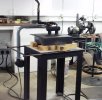- Joined
- Oct 17, 2010
- Messages
- 2,424
Ok guys, I'm in the process of building a forge, and I've got the basic details worked out. Inswool, burners, etc. etc. no problem, but the deeper I dig into the murky waters of refractory "coatings" and "castables", the less certain I become.
I'm one of those people that's not content with "good enough". I'm not a robot perfectionist, but I like making very informed choices, and when it comes to this area, there seem to be ALOT of options, and very little solid information.
I'll be using an inswool lining, that's easy, but after that, what's the creme for durability and efficiency?
Satanite
Mizzou
Bubble Alumina (Ellis variety)
Kast-o-Lite 3000
AP Green #36
Those are just some of the regular options. Then there's more exotic stuff like Kaolite 3300/Plicast LWI 606, to name a couple. Which I suspect are the same or similar to what Darren sells as "Bubble Alumina" which seems to be a generic name for a certain range of extremely high alumina refractories.
Obviously the generic options are to either cast a liner which is very durable and flux resistant, but not very heat efficient, or use a liner of inswool (or equiv), coated with various combinations of the aforementioned products which yield differing levels of efficiency vs durability and flux resistance.
Confusion comes in some forms from the delineation of "castables" and "coatings", of which I think many of the products labeled "coatings" are still castables. Where as things like ITC-100 or Plistix might be more adequately separated as coatings specifically.
Obviously I know I'll be using an Inswool liner, but the "coating" options are where the possibilities start seeming endless, without knowing more of the rules.
I've heard of people soaking a layer of inswool for instance in mizzou. The standard option seems to be using Satanite for the top of the forge and "bubble alumina" for the bottom, and coating the whole thing with an IR coating like ITC-100.
Would it be better to coat the entire thing in Bubble Alumina or an equivalent Ultra-high alumina product like Plicast LWI 606 (~95% al2o3), then coat or not with ITC-100 or Plistix? Should I soaking the top layer (I'll be using two 1" layers) of Inswool in some concoction and then coat over that with a separate product?
Should I use Mizzou on the top and Bubble Alumina on the bottom, etc. etc. etc?
What do you believe the absolute best combination of materials would be to reach peak thermal efficiency coupled with peak flux resistance if building your dream forge and economy wasn't an issue? Why?
I know it's long winded, sorry, but I'd really like some knowledgeable input on this. Please hold the "just use satanite and a firebrick cause it's cheap and works fine for me" comments, I'm already aware of that option, and may end up doing that, but I'd really like to know what the full scope of possibilities are and why one is better than an other..
Thanks!
Javan
I'm one of those people that's not content with "good enough". I'm not a robot perfectionist, but I like making very informed choices, and when it comes to this area, there seem to be ALOT of options, and very little solid information.
I'll be using an inswool lining, that's easy, but after that, what's the creme for durability and efficiency?
Satanite
Mizzou
Bubble Alumina (Ellis variety)
Kast-o-Lite 3000
AP Green #36
Those are just some of the regular options. Then there's more exotic stuff like Kaolite 3300/Plicast LWI 606, to name a couple. Which I suspect are the same or similar to what Darren sells as "Bubble Alumina" which seems to be a generic name for a certain range of extremely high alumina refractories.
Obviously the generic options are to either cast a liner which is very durable and flux resistant, but not very heat efficient, or use a liner of inswool (or equiv), coated with various combinations of the aforementioned products which yield differing levels of efficiency vs durability and flux resistance.
Confusion comes in some forms from the delineation of "castables" and "coatings", of which I think many of the products labeled "coatings" are still castables. Where as things like ITC-100 or Plistix might be more adequately separated as coatings specifically.
Obviously I know I'll be using an Inswool liner, but the "coating" options are where the possibilities start seeming endless, without knowing more of the rules.
I've heard of people soaking a layer of inswool for instance in mizzou. The standard option seems to be using Satanite for the top of the forge and "bubble alumina" for the bottom, and coating the whole thing with an IR coating like ITC-100.
Would it be better to coat the entire thing in Bubble Alumina or an equivalent Ultra-high alumina product like Plicast LWI 606 (~95% al2o3), then coat or not with ITC-100 or Plistix? Should I soaking the top layer (I'll be using two 1" layers) of Inswool in some concoction and then coat over that with a separate product?
Should I use Mizzou on the top and Bubble Alumina on the bottom, etc. etc. etc?
What do you believe the absolute best combination of materials would be to reach peak thermal efficiency coupled with peak flux resistance if building your dream forge and economy wasn't an issue? Why?
I know it's long winded, sorry, but I'd really like some knowledgeable input on this. Please hold the "just use satanite and a firebrick cause it's cheap and works fine for me" comments, I'm already aware of that option, and may end up doing that, but I'd really like to know what the full scope of possibilities are and why one is better than an other..
Thanks!
Javan


